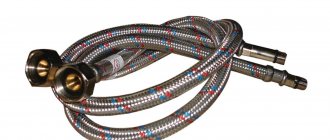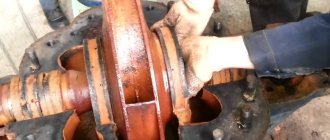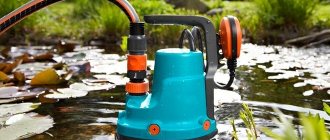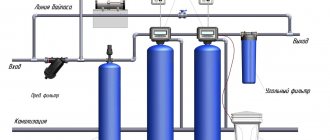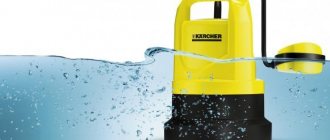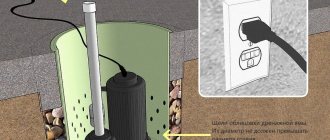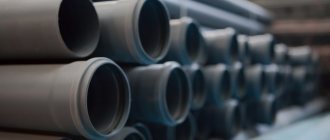selection of deep pumps for different types of wells
To ensure water supply from a well, special equipment is used to supply water. There are many models of such equipment on sale with different parameters. What technical data should deep well pumps have, and how to choose them correctly?
Purpose of submersible pumps
Borehole pumps, due to their small diameter, are capable of lifting liquid from deep artesian sources
Basically, submersible pumping equipment is used to lift liquid from sources located underground. Most of them are multi-stage - the deeper the well, the more stages, which create strong torque and maintain pressure in the system.
Borehole pumps are capable of operating very deep in artesian wells - they are called deep wells. They lift liquid from 300 - 400 meters, industrial models - even deeper.
Submersible equipment is used to set up homemade pumping stations. Since similar purchased units cannot lift liquid below 8 meters, there is a need to connect a hydraulic accumulator to a deep submersible pump, and also install a pressure switch.
Due to the strong pressure, submersible equipment is used in summer cottages for watering gardens, in drip systems, and for arranging outdoor showers. Control can be manual or automatic. The mechanics are suitable for one-time use, but for water supply to a private home it is better to install automation so that the relay is triggered due to pressure drops and turns on the unit independently.
Where are downhole units used?
Submersible pumps are used in water supply systems of private houses. In this case, install any household model that meets the technical characteristics.
The liquid also reaches the water tower thanks to submersible equipment, and from there it is distributed further. Here, more powerful units are needed that can serve several country houses or residential buildings.
Powerful submersible pumps extract mineral water from the depths of the earth and then bottle the liquid before sending it to points of sale. Mineral springs are located deep - up to 1500 m, so pumps for pumping are used of an industrial type, with many stages.
Downhole equipment is suitable for wells. According to the instructions, some models can be installed horizontally, but not all are suitable for this. For shallow wells, units with low power are selected.
Advantages of devices: which one to choose?
| Kinds | Advantages |
| Submersible |
|
| Superficial |
|
Types of equipment, technical characteristics
Centrifugal pump design
Submersible pumps are available for domestic and industrial purposes. The difference is in power, since industrial models are most often deep-sea and pump liquids from a distance of 1000 meters or more to the water surface.
The installation scheme for rod and rodless units differs. In the first case, it is a device whose engine is located on the surface of the earth, and a rod is lowered into the well - the submersible part, which is necessary to transmit thrust.
Rodless mechanisms are a pump and a motor in one housing. This is more convenient during installation and operation, which is why such models are more common in everyday life.
Pumps differ in design:
- centrifugal;
- vortex;
- screw;
- vibration.
Centrifugal units have a working mechanism in the form of a wheel with an impeller, which rotates on a shaft using electricity. Under the influence of centrifugal force, water rises along the walls of the housing into the outlet pipe. An area of low pressure is created in the middle part, which sucks in a new portion of liquid.
Centrifugal mechanisms are the most powerful of all existing ones. The design can have from one stage to 20. On average, 3–4 wheels with blades are sufficient for household needs.
The weak point of a centrifugal pump is the impeller. If there is sand or stones in the water, they will sooner or later damage the mechanism, so for such devices you need to immediately buy a filter if it is not included in the kit. Small fractions of sand penetrate into the housing even with a coarse filter, so the internal working part must be made of durable metal. Because of this, centrifugal pumps are more expensive than, for example, vortex pumps.
Vibration units operate like piston mechanisms using a membrane that creates high-frequency vibrations. Such equipment is characterized by low power and, therefore, low pressure. Suitable for summer cottages, but similar equipment is not used for water supply to a private home. The cost of vibration pumps is not high. In addition, there is a danger that vibrations will destroy the casing.
Vortex pumps are similar in principle to centrifugal pumps. A distinctive feature is the presence of grooves on the walls, which enhance flow and turbulence. The design is simpler, so the price of a deep-well pump for vortex-type wells will be lower. Vortex equipment is designed for very pure liquid, so in the presence of solid inclusions it quickly fails. The pump operates silently and does not produce vibrations that destroy the well.
Screw units have a simplified design. The water rises using an Archimedean screw. Such equipment is practically not used for water supply systems, but it has found application among summer residents who make wells for watering their plots. The pump can even work with dirty water that is pumped from rivers or lakes. In industrial enterprises, screw equipment is used to pump out viscous liquids.
Vortex
Vibrating
Screw
Operating principle of a deep-well pump
Each type of equipment works differently. The principle of operation is largely influenced by the elements with which the deep-well pump is equipped. The vibration unit performs its functions by moving the piston. When electricity is supplied, an electromagnetic field is created inside the device, which attracts the vibrator - this drives the pump piston. At the same time, a discharged pressure is generated in the working chambers of the unit, which pushes water into the free space of the chambers. Using the same principle, water passes through the channels into the pipeline.
The operating principle of a centrifugal deep-well water pump is based on the rotation of the impeller. In this case, a centrifugal force is created along the perimeter of the working blades, pushing water from the suction pipe into the pressure channel, and then into the pipeline. Another type of equipment works on the same principle - a screw pump.
Advantages and disadvantages
Each type of submersible pump has its own advantages and disadvantages. For example, centrifugal pumps are very sensitive to the purity of the pumped liquid. Their disadvantage is their high cost compared to all other types. The rodless centrifugal unit is silent in operation, since its body is in the liquid. The service life depends on the number of on and off cycles, so a hydraulic accumulator is most often connected to it to extend the operating time.
Disadvantages of vibration pumps:
- React to sand in water.
- Lack of automation elements.
- The well silts up faster, as it creates waves that lift dirt from the bottom.
- High noise level.
- Low power and pressure.
- Short service life.
The advantages of screw equipment include:
- high pressure;
- low noise level;
- the ability to pump out dirty liquid without damaging the housing.
The efficiency of the screw mechanism is low, the productivity is low. Frequent replacement of parts is required, since there are many rubbing elements inside the case.
Installation and operation
The installation and connection diagram of the submersible pump is extremely simple:
- the unit is lowered into the source
- installation of a submersible pump in a well: check for cable distortions; they should all be evenly spaced. For greater reliability, they can be fastened with metal stainless steel clamps every 2.5 m. This will also reduce the risk of loops forming
- must be hung from the head - there must be special brackets and hooks
- if there is a hydraulic accumulator, set it up
- connecting a submersible pump to the network, starting, testing
The operation of wells with submersible electric centrifugal pumps takes into account the fact that they should be checked once every 2 years: inspect for chips, cracks, clean the pipe, filter, test the rotation of the shaft, the tightness of the seals.
Pumps for summer cottages must be equipped with filters. This is especially true for products that have an impeller and screws inside and is less relevant for vibration pumps.
The use of multi-stage devices for sand wells, if there is no filter, quickly clogs their chambers. Then it is better to use the vibration type, but there must be casing pipes or solid rock walls.
Criterias of choice
Before buying a unit for a water supply system, you need to take into account the technical characteristics of submersible pumps for water wells, and also decide what the equipment will be used for.
Factors that play an important role during operation:
- The amount of liquid required for a private home and the residents living in it.
- Pressure If the well is located far from the house, it will require power capable of delivering the liquid to the entry point through a horizontal pipe. If the house is two or three stories high, it will take effort to lift the liquid to the height of the building. Power is usually selected with a reserve - in case of installing additional water consumption points or building a garage, bathhouse, or swimming pool.
- Well depth. For sources on sand there is no need to install powerful equipment, but for artesian wells a powerful centrifugal pump will be required.
- Quality of the pumped liquid – clean or dirty. Depending on this, you can choose a mechanism that can work fully and will not break quickly.
- Temperature of the pumped liquid.
- The presence of protection mechanisms - dry running sensor, overheating.
- Materials from which the internal parts and body are made. Metal components of the structure provide better tightness and last longer.
- Pump diameter relative to the well. It is necessary that at least 2 cm remain from the pipe wall to the body so that the liquid flows around the unit and cools it. The correct size will ensure that the equipment does not get stuck inside the pipe.
- Removing the electrical outlet from the pump installation location. The cable must be of sufficient length.
In order not to overpay, you can first consider domestically produced devices. If they are made with high quality, their price will not be very cheap. If you expect long-term operation, it is better to select equipment from German, Italian or Swedish brands.
Companies and manufacturers of pumps
On the Russian market, well pumps are represented by a huge number of models from two dozen manufacturers. Although such equipment is not ceramic brick, which is produced in almost every large settlement, there are also many companies that make household hydraulic pumps. Moreover, there are both imported and domestic brands.
Among the most popular manufacturers of well electric pumps, mention should be made:
- PROMELEKTRO with the brand “Aquarius” (Russia);
- GILEX with the brands “Vodomet” and “Jumbo” (Russia);
- Grundfos (Denmark, production in Russia);
- Aquario with models under the ASP brand (Italy);
- Whirlwind (Russian brand, made in China);
- Wilo (Germany);
- ZDS (Italy);
- Elitech (China).
Gilex Vodomet Prof 55/50 - cost about 7,000 rubles (2018)
Also in Russia, Belarus and China there are several manufacturers producing inexpensive deep-well pumps under the Malysh brand. The design is the same in all cases, but the build quality and components are different.
Grundfos SQ 2-70 - cost about 46,000 rubles (2018)
If you need an affordable and reliable pump for a drinking water well, then you should take the “Aquarius” or “Vodomet”. This domestic technology was originally developed for Russian conditions. Models from Grundfos or Wilo, recognized European brands, will cost a little more. The rest outperform this four in terms of cost or quality, but are inferior to them in terms of service.
UNIPUMP ECO-1 - cost about 11,000 rubles (2018)
Before buying a pump suitable for its characteristics, it is worth finding out the addresses of service centers. A pump for an autonomous water supply well is not a banal roof made of corrugated sheets, which does not require high-tech maintenance. Moreover, if the selected model has to be sent for repair under warranty by mail across the whole country, then this option should be abandoned immediately. There is always plenty to choose from for a well pump. There are plenty of analogues in stores.
Installation and connection features
The pump is installed according to the instructions. You can entrust the installation to professionals, but if the well is properly organized, installing the unit will not be difficult even for a beginner. The instructions describe all the steps in detail. To secure it, you need to use durable materials so that the unit does not break during operation.
After installation, it is necessary to inspect the well and pump once a year - clean and rinse. To do this, the mechanism is taken out and inspected. Imported centrifugal pumps do not require frequent repairs or maintenance, but all other types require regular cleaning and rinsing of the housing from dirt and sand.
The cost depends on the technical characteristics of the equipment, as well as the manufacturer’s brand. It is not recommended to buy very cheap Chinese pumps, as they quickly break down, and it is almost impossible to find spare parts for them. In addition, the model may not be dismountable, so it will have to be thrown away.



